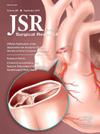预测需要体外心肺复苏的非心脏儿科患者的存活率
IF 1.7
3区 医学
Q2 SURGERY
引用次数: 0
摘要
体外生命支持在心脏骤停期间的应用称为体外心肺复苏(eCPR)。非心脏疾病接受eCPR的儿科患者死亡率仍然很高,影响生存率的因素尚未明确。我们假设eCPR幸存者比非幸存者更有可能在插管前出现较不严重的电解质紊乱。方法回顾性分析我院独立儿童医院2013年1月至2023年12月的体外膜氧合(ECMO)数据。评估的变量包括人口统计学、诊断、血气值、心肺复苏术时间和生存率。Kruskal-Wallis测试用于比较存活者和非存活者的产前实验室和心肺复苏术持续时间。结果:我们确定了21例在ECMO插管期间接受心肺复苏术的患者,时间超过10年。最常见的诊断是呼吸衰竭(n = 8.38%)。成功启动ECMO前CPR的中位持续时间为60分钟(四分位数范围15-80)。静脉-动脉ECMO (n = 20, 95%)是最常见的插管方法。ECMO的中位运行时间为84小时(四分位数范围27-183)。1例患者在ECMO插管期间死亡(n = 1, 4.7%)。8例患者存活出院(38%)。插管前较高的pH值、动脉氧分压和碳酸氢盐水平与生存率相关(P < 0.05)。结论:在本研究中,存活患者的围前pH值、动脉氧分压和碳酸氢盐中位数明显高于非存活患者。可能影响生存能力的孕前特征可能有助于制定关于eCPR候选人纳入和排除标准的决策。本文章由计算机程序翻译,如有差异,请以英文原文为准。
Predicting Survivability of Noncardiac Pediatric Patients Requiring Extracorporeal Cardiopulmonary Resuscitation
Introduction
Application of extracorporeal life support during cardiac arrest is termed extracorporeal cardiopulmonary resuscitation (eCPR). Mortality in pediatric patients undergoing eCPR for noncardiac conditions remains high and factors influencing survival are not well-defined. We hypothesized that eCPR survivors are more likely to have less severe electrolyte derangements prior to cannulation than nonsurvivors.
Methods
A retrospective review of extracorporeal membrane oxygenation (ECMO) data at our free-standing children's hospital from January 2013 through December 2023 was performed. Variables evaluated included demographics, diagnosis, blood gas values, CPR time, and survival. Kruskal–Wallis test was used to compare precannulation labs and CPR duration in those who survived to the nonsurvivors.
Results
We identified 21 patients who underwent CPR during ECMO cannulation over a 10-year period. The most common diagnosis was respiratory failure (n = 8, 38%). The median duration of CPR prior to successful ECMO initiation was 60 min (interquartile range 15-80). Veno-arterial ECMO (n = 20, 95%) was the most common method of cannulation. The median ECMO run time was 84 h (interquartile range 27-183). A single patient died during ECMO cannulation (n = 1, 4.7%). Eight patients survived to discharge (38%). Higher pH, partial pressure of arterial oxygen, and bicarbonate levels prior to cannulation were associated with survival (P < 0.05).
Conclusions
In this study, precannulation pH, partial pressure of arterial oxygen, and bicarbonate median values were significantly higher in those who survived compared to the nonsurvivors. Precannulation characteristics that may influence survivability can potentially assist with decision making regarding inclusion and exclusion criteria for eCPR candidates.
求助全文
通过发布文献求助,成功后即可免费获取论文全文。
去求助
来源期刊
CiteScore
3.90
自引率
4.50%
发文量
627
审稿时长
138 days
期刊介绍:
The Journal of Surgical Research: Clinical and Laboratory Investigation publishes original articles concerned with clinical and laboratory investigations relevant to surgical practice and teaching. The journal emphasizes reports of clinical investigations or fundamental research bearing directly on surgical management that will be of general interest to a broad range of surgeons and surgical researchers. The articles presented need not have been the products of surgeons or of surgical laboratories.
The Journal of Surgical Research also features review articles and special articles relating to educational, research, or social issues of interest to the academic surgical community.

 求助内容:
求助内容: 应助结果提醒方式:
应助结果提醒方式:


